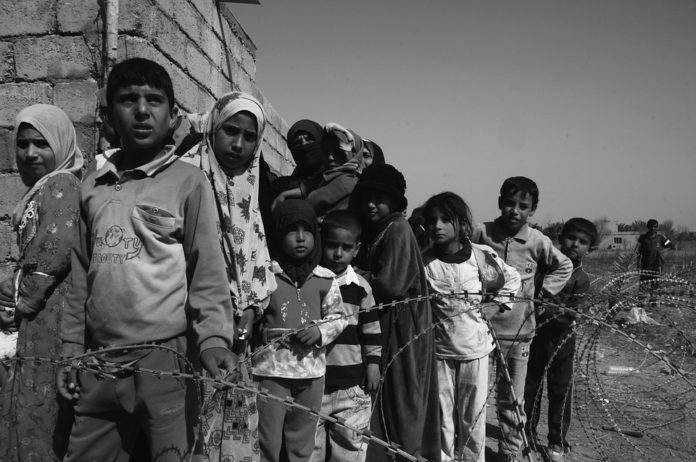„Adults go to war, but they don’t realise what damage
they are doing to children.“
Nicaraguan child
It is said that children are our future. How can we make such statements when children living in different conditions, existing in conditions of fear, are subject to psychological and physical trauma?
Combat activities and population displacement caused by conflict have direct effects on child mortality and morbidity. Unfortunately, 15 million children are directly caught up in violent conflict, 10 million children have fled conflict and one billion children live in countries affected by armed conflict. Over a third of the world’s child deaths happen in countries that are affected by conflict or that have sizeable refugee populations. So, more than 1 in 10 children worldwide are affected by armed conflict (Thorning-Schmidt, 2017; Kadir, 2018).
Effect of Armed Conflict on Children’s Health
Conflicts force children and families to leave their homes to seek safety within national borders and across international borders( there are nearly two-thirds of the 28 million forcibly displaced children). During the relocation, children may become separated from their families and are more vulnerable to infections, psychological trauma, and exploitation (Das,2019).
Children exposed to armed conflict suffer a broad range of injuries and illness that can be directly attributed to conflict. One third of included studies describe a range of physical injuries affecting all organ systems, broadly classified as penetrating injuries, blunt trauma, crush injuries and burns. Estimates suggest that the prevalence of rape and sexual exploitation of children in armed conflict is increasing. In addition to the psychological trauma of sexual violence during armed conflict, girls who suffer rape are less likely than adults to seek medical attention and are at increased risk for sexually transmitted infections, pregnancy and so on. Boys also experience rape. Those who survive their experiences suffer from psychological trauma and often face stigma and exclusion when they return to their communities (Kadir, 2018).
Thousands of children are killed every year as a direct result of fighting from knife wounds, bullets, bombs and landmines, but many more die from malnutrition and disease caused or heightened by conflict. Wars interrupt food supplies and destroy crops and agricultural infrastructures. They also destroy water and sanitation systems along with health services. Of the 10 countries with the highest rates of under five deaths, seven are affected by armed conflict (Machel, 2000).
Exposure to armed conflict has social and psychological repercussions that endure long after the termination of hostilities.Children who are affected by war have an increased prevalence of posttraumatic stress disorder, depression, anxiety, and behavioral and psychosomatic complaints (Kadir, 2018).
- The statistics around the world never cease to be terrifying (English, 2018):
- The Armenian – Azerbaijani conflict led to the closure of the schools and, under threat of life, to the relocation of families from the zones of shelling. The situation of children living in the immediate vicinity of the contact line remains especially dangerous. In these areas, shelling and the highest level of mine risk pose a deadly threat.
- In eastern Ukraine, more than 5 years of conflict have led to devastating consequences for the education system. Hundreds of schools were destroyed and damaged, leaving 700,000 children going to school in unsafe environments associated with recurrent conflicts and threats from unexploded ordnance.
- The highest rates are in Syria, where children have been victims of protracted conflict. The reason for the death of children was the fighting or suicide attacks, in addition, children froze on the road, starved when they tried to leave the conflict region.
- In Afghanistan, violence and bloodshed continues daily. Children account for 89 percent of the total number of casualties resulting from the impact of the explosive remnants of war.
- Children in Palestine and Israel live in fear and are subject to psychological and physical trauma.
- In South Sudan, continuing conflict and volatility have justify 6.1 million people living in extreme hunger during the annual dry season. Despite the promised signing of a new peace agreement and the resulting glimmer of hope for children, cases of abuse of women and children continue to be reported.
- In Somalia, more than 1,800 children were recruited and 1,278 abducted by warring parties during the first nine months of this year.
However, the precise effect of any given armed conflict on a child’s health is difficult to determine. Conflicts disrupt the health information systems that report morbidity and mortality under typical circumstances. Hence, most published estimates of the population health effects of armed conflict are based on media reports and official pronouncements from governments and combating parties, which may politicize or intentionally misrepresent information. For example, in a report by the UN special rapporteur on children and armed conflict, it was estimated that thousands of children had died recently. But, only 591 child deaths were verified by the UN, which accounts for barely 0.01% of the 50 000 deaths. As a result, there are no pooled estimates for the total number of children killed, injured, orphaned, handicapped, and psychologically traumatized by exposure to armed conflicts (Kadir, 2018).
„Childhood has been stolen from millions of children“
the UNICEF representative
Over the past years, children in a world of conflict around the world continue to suffer from extreme levels of violence, and the global community continues to fail to protect them. According to international law, the involvement of children in armed conflict and the targeting of health workers and facilities by combatants are human rights violations. UNICEF calls on all warring parties to fulfil their obligations under international law and immediately end violence against children and attacks on civilian infrastructure, including schools, hospitals, water supplies, etc. UNICEF also calls on states with influence on the parties to the conflict to use it to protect children (English, 2018).
Whether they become our leaders of tomorrow or members of society, it is the government’s responsibility to ensure that the world’s children will be able to play their unique role defined not by the violence and suffering inflicted on them, but by their potential and character. As a result, even short-lived armed conflicts affect child health and wellbeing across the life course and through adulthood (Thorning-Schmidt, 2017).
And yet, our promises to children throughout the world remain unfulfilled.
Author: Anastasiia Shevchenko
Photo source: Fox, K. (2019). Almost 1 in 5 children live in conflict zones. https://edition.cnn.com/2019/02/14/africa/1-in-5-children-live-in-conflict-zones-intl/index.html
References:
Das, J. K. (2019). Effects of armed conflict on child health and development: A systematic review. LINK: https://www.ncbi.nlm.nih.gov/pmc/articles/PMC6334973/
English, J. (2018). В 2018 году мировое сообщество не смогло защитить детей, проживающих в зонах конфликта. LINK: https://www.unicef.org/eca/ru/Пресс-релизы/в-2018-году-мировое-сообщество-не-смогло-защитить-детей-проживающих-в-зонах-конфликта
Kadir, A.(2018). The Effects of Armed Conflict on Children. LINK: https://pediatrics.aappublications.org/content/142/6/e20182586
Machel, G. (2000). The Impact of Armed Conflict on Children. https://reliefweb.int/sites/reliefweb.int/files/resources/INTERNATIONAL%20CONFERENCE%20ON%20WAR.pdf
Thorning-Schmidt, H. (2017). Protecting Children in War and Conflict: European and global implications for child rights. LINK: https://www.lse.ac.uk/Events/Events-Assets/PDF/2017/2017-LT01/Transcript-HelleThorningSchmidt.pdf



















